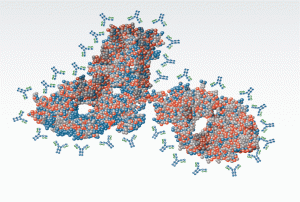Biologicals are increasingly being used in therapy, helping to cure thousands of patients, or at least improving their quality of life.
Research continues to move forward in this area, as proved by 7 400 citations in 2014 only when using “biologicals” as a search term, or about 200 citations when using “therapeutic mAb”. Many research groups, especially those working on Oncology, continue to investigate on the mechanism of action of biologicals, specially mAbs, as well as on any possible resistances found in non-responsive patients.
For these mechanistic or functional studies, antibody-based techniques such as ELISAs, antibody arrays, flow cytometry, etc. are routinely performed, using samples from patients being treated with therapeutic mAbs.
mAbs are usually humanised, meaning that they are first raised in animal models (e.g. mouse) and then modified in their structure so that they resemble human mAbs. However, one cannot forget the origin of these therapeutic mAbs when using antibody-based technologies, i.e. one always needs to keep in mind that non-specific cross-reactivity of the therapeutic mAb with the antibodies present in the assay may exist.
At a theoretical level, one should thoroughly evaluate the epitope recognised by the antibodies present in the technology used for the study, and see if there may be a cross-reaction with any sequence present in the humanised mAb. This can be easy for techniques using monoclonal antibodies, but it might be not possible for technologies using polyclonal antibodies. Moreover, not all manufacturers are willing to share this information, either because it is proprietary, or because it is unknown. Epitope mapping is not routinely done by most antibody manufacturers.
Therefore, the only way sometimes to know about these possible non-specific cross-reactions, that may jeopardise the studies performed with samples coming from mAb-treated patients, is to test this empirically. For example, an ELISA (using a polyclonal-monoclonal pair) can be run in parallel with a WB (using a monoclonal with a known epitope), to check whether the detection pattern is the same. If a cross-reaction is detected, the solution is then to either use WB only for the study, or test another ELISA. Use of WB has some advantages in this case, but it lacks the throughput and quantification power associated to ELISA tests.
Nevertheless, testing different ELISAs and antibodies for WB can be cumbersome… and expensive. This is why it is convenient to have either small validation sizes for antibodies, or risk-free trial programmes for ELISA kits.
Working with samples treated with mAbs? We’d be happy to hear from you!



